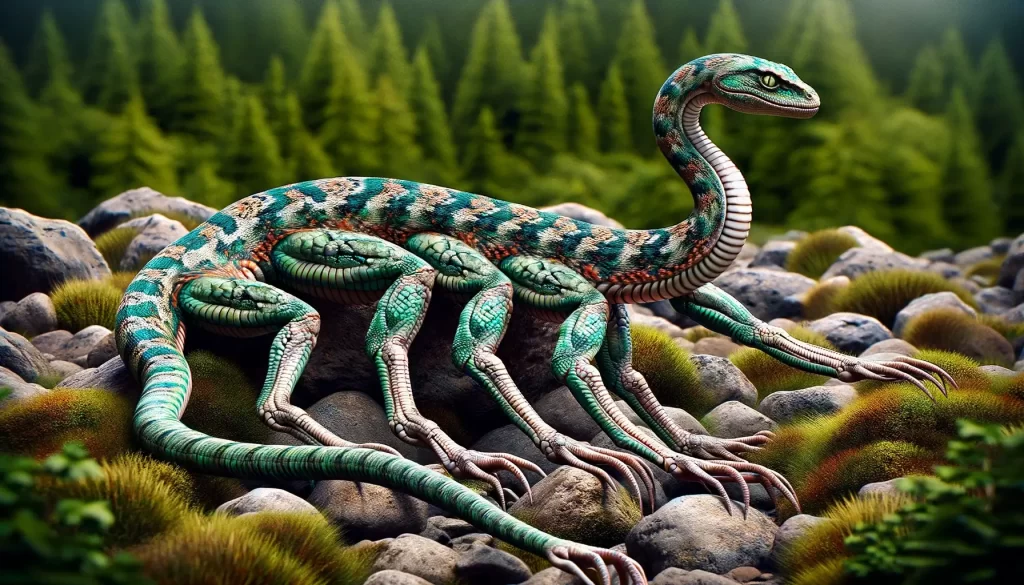Did you know that snakes are legless reptiles, yet they still possess remnants of their evolutionary past?
Snakes do not have legs. They are a part of the reptilian family known as squamates, which evolved over millions of years to lose their limbs and develop elongated bodies and specialized scales to aid in slithering. However, some fossil records and certain existing snake species have vestigial remnants of pelvic bones, evidence of their legged ancestors.
Despite their lack of legs, snakes have adapted remarkable anatomical features that have allowed them to thrive in various environments.
Let’s delve into the fascinating world of snake anatomy and uncover the secrets behind their unique form of locomotion.
Key Takeaways:
- Snakes are legless reptiles with specialized adaptations for locomotion.
- Genetic research has identified the PTCH1 gene as a key player in snake limblessness.
- Snakes possess a range of adaptations that compensate for the absence of limbs, such as specialized sensory organs and skull flexibility.
- Ancient snake fossils suggest that the loss of legs was a gradual process.
- Hox genes play a critical role in snake development and the evolution of limblessness.
The Evolution of Snakes
Through groundbreaking genetic research, we have unraveled the fascinating story behind snake evolution.
By sequencing the genomes of various snake species, scientists have made significant discoveries regarding the genetic basis for limblessness in these extraordinary creatures.
One crucial gene that has been identified is PTCH1, responsible for limb development.
Analysis has revealed significant DNA alterations in this gene present in all snakes studied.
These mutations in PTCH1 provide insights into the genetic foundation of their extraordinary limblessness.
These groundbreaking findings shed light on the intricate blueprint of snake evolution, highlighting the genetic mechanisms that have shaped their remarkable adaptations.
The evolution of snakes from their legged ancestors is a testament to nature’s ingenuity and the ability of organisms to adapt and thrive.
Understanding the PTCH1 Gene
The PTCH1 gene plays a critical role in limb development in various organisms.
Through extensive research on snake genomes, scientists have observed specific DNA alterations in the PTCH1 gene associated with snake evolution.
These mutations likely occurred as a result of evolutionary pressures and adaptations to different environments.
Snakes with limblessness gained advantages in their movements and hunting strategies, allowing them to thrive in varied habitats around the world.
The Genetic Basis for Limblessness
Studying the genetic basis for limblessness in snakes not only provides insights into snake evolution but also deepens our understanding of how genetic variations shape diverse anatomical structures.
The mutations in the PTCH1 gene in snakes have been instrumental in deciphering the genetic foundation for limb development.
By identifying these DNA alterations in snake genomes, scientists have paved the way for further research on the mechanisms underlying limb development and the evolutionary history of diverse species.
- Snake evolution is shaped by significant DNA alterations in the PTCH1 gene.
- All snakes studied so far possess these mutations, providing a likely genetic basis for their limblessness.
- Understanding the PTCH1 gene sheds light on the genetic mechanisms underlying snake adaptations.
- Further research is needed to unravel the complexities of snake evolution and limb development fully.
The Function of Limbs in Snakes
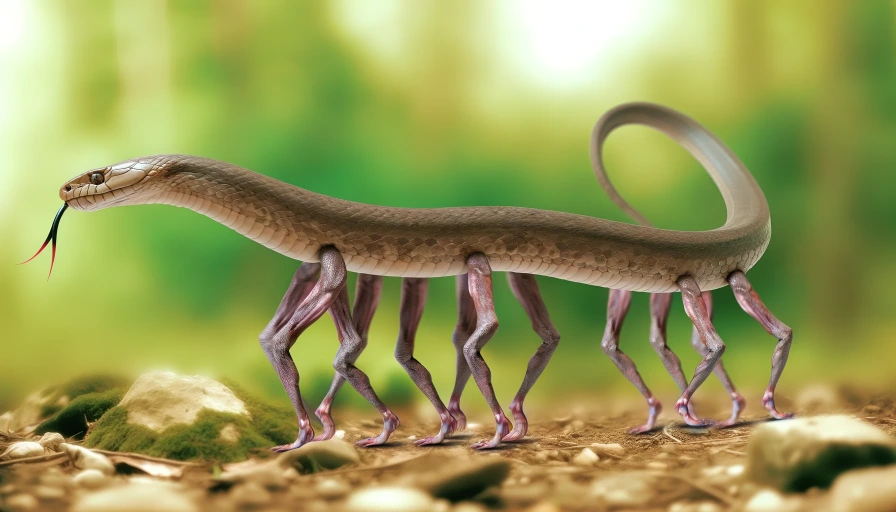
While snakes lack external limbs, their bodies are highly specialized for their unique form of locomotion.
Their elongated bodies and flexible scales allow for efficient movement through various environments, from slithering through grass to swimming in water.
Additionally, their muscles work in tandem with their scales to propel them forward.
One of the key snake characteristics is their elongated body, which allows them to navigate tight spaces and move with great agility.
The absence of limbs grants them the ability to maneuver through narrow crevices and burrows, making them highly adaptable predators.
The snake’s body structure plays a crucial role in its movement. The scales covering their bodies provide both protection and a low-friction surface, reducing energy expenditure and enhancing their ability to glide effortlessly across different surfaces.
These scales also aid in gripping surfaces, allowing snakes to climb trees or move on slippery rocks.
Snake limbs, in the form of muscles, are integral to their locomotion. The powerful muscles found in their bodies contract and relax in a wave-like motion, driving their bodies forward.
This serpentine movement is achieved through the coordination of the muscles on either side of their body.
It is important to note that while snakes lack legs, they have evolved alternative adaptations to compensate for the function of limbs.
These adaptations, along with their unique body structure and muscular coordination, allow snakes to excel at traversing a wide range of environments and capturing their prey with precision.
In conclusion, snakes have remarkable characteristics and body structures that enable them to thrive without limbs.
Their elongated bodies, flexible scales, and coordinated muscular movement contribute to their efficient locomotion and exceptional adaptability.
By understanding the function of these limbless creatures, we gain valuable insights into the fascinating world of snakes and their unique place in the animal kingdom.
The Loss of Legs in Snake Ancestors
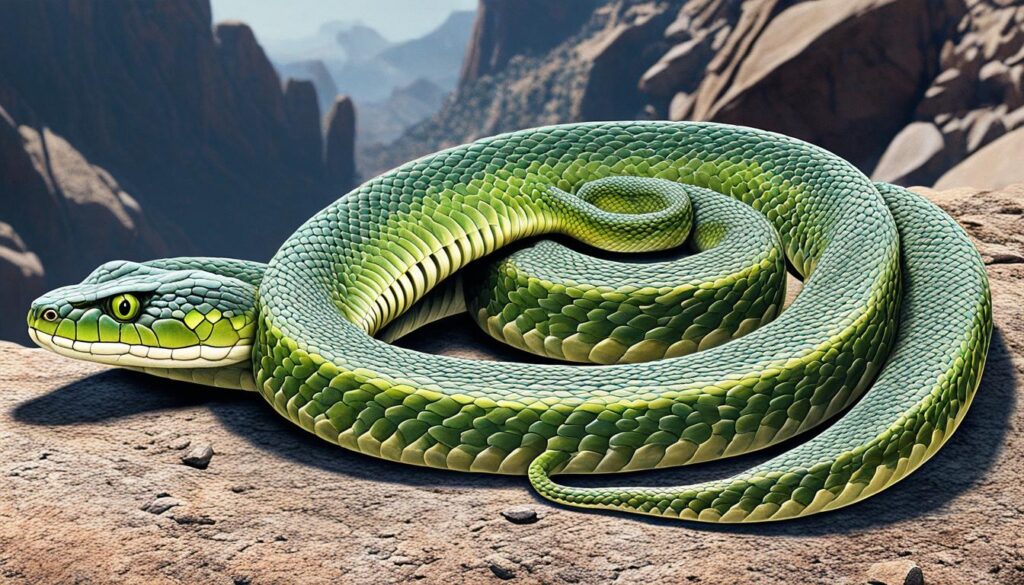
The fascinating evolution of snakes took an unexpected turn approximately 70 million years ago when their ancestors lost their once functional limbs.
This transformation from legged to legless occurred as snakes adapted to their environments and developed new methods of locomotion.
This significant change allowed snakes to become incredibly successful predators and colonize diverse habitats around the world.
Without the hindrance of legs, snakes were able to navigate their surroundings with remarkable agility and precision.
The Evolution of Snake Locomotion
With the loss of their limbs, snakes had to adapt their bodies to achieve efficient movement.
The elongated shape of their bodies, along with specialized muscle and scale coordination, allowed them to slither effortlessly through the environment.
Snakes are capable of a variety of locomotor movements, including rectilinear propulsion, lateral undulation, and sidewinding, each suited to different terrains and challenges.
These adaptations enabled them to explore and colonize various habitats, from dense forests to deserts and even aquatic environments.
Colonizing Diverse Habitats
By shedding their legs, snakes gained access to new ecological niches. They became proficient hunters, relying on their sleek bodies and powerful jaws to capture prey.
The ability to navigate confined spaces and burrows gave them an advantage over other predators, allowing them to pursue small mammals, birds, fish, and even other reptiles.
Snakes’ miraculous adaptation to leglessness has allowed them to survive and thrive in some of the most extreme environments on Earth, demonstrating their incredible resilience and evolutionary success.
- Legless snakes, such as the African puff adder, have adapted to sandy environments by burying themselves in the sand and ambushing unsuspecting prey.
. - Like the yellow-bellied sea snakes, sea snakes have evolved flattened tails and paddle-like ventral scales, enabling them to swim gracefully through the ocean.
. - Australian python species, such as the carpet python, have perfected the art of climbing trees, utilizing muscular contractions to grip onto branches and stealthily capture prey.
The Genetic Basis of Snake Leglessness
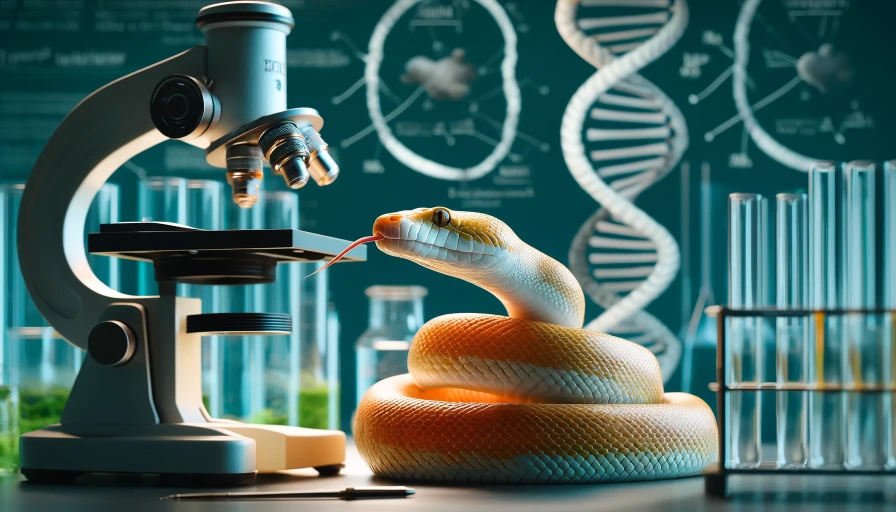
The groundbreaking study on snake evolution has provided fascinating insights into the genetic basis of snake limblessness.
Researchers have identified specific DNA alterations in the PTCH1 gene that are responsible for the absence of limbs in snakes.
These genetic changes have been observed in all snake species, indicating a common mechanism for the loss of limbs.
Through variations in the PTCH1 gene, snakes have undergone a remarkable adaptation that has shaped their evolutionary path.
The loss of limbs in snakes is a result of specific genetic alterations that occurred over millions of years.
By studying these genetic changes, scientists can gain a deeper understanding of the mechanisms that led to this extraordinary adaptation.
The PTCH1 gene is responsible for limb development in many animals, including snakes.
Through extensive genetic research, scientists have determined that mutations in this gene are present in all snake species, suggesting a common genetic basis for snake limblessness.
This genetic similarity points to a shared evolutionary history, where snakes evolved from legged ancestors and later adapted to a limbless lifestyle.
The Importance of Further Research
While the genetic alterations in the PTCH1 gene have been identified, there is still much to learn about the underlying mechanisms that led to the loss of limbs in snakes.
Further research in this area may uncover additional genetic factors or interactions that played a role in this adaptation.
Understanding the intricate genetic pathways involved in snake evolution can provide valuable insights into the broader field of evolutionary biology.
Implications for Serpent Evolution
The genetic basis of snake leglessness sheds light on the remarkable adaptability of these creatures.
Snakes have successfully colonized diverse habitats around the world and evolved unique body structures and sensory capabilities.
The loss of limbs has allowed snakes to excel in their specialized modes of locomotion, showcasing nature’s ingenuity in adapting to different environments.
As researchers continue to unravel the genetic mysteries of snake evolution, our understanding of serpent limbs and their specific adaptations will deepen.
Through this knowledge, we can further appreciate the awe-inspiring diversity and complexity of the natural world.
Adaptations for Limblessness in Snakes

Not having limbs has allowed snakes to develop a wide range of specialized adaptations.
These adaptations have made snakes successful predators in their environments. Here are some of the remarkable adaptations that legless reptiles have acquired:
Pheromone Detection Organ
Snakes possess a distinct organ on the roof of their mouths known as the Jacobson’s organ.
This organ allows them to “taste” scents in their surroundings, enhancing their ability to detect pheromones and locate prey.
Flexible Skulls
Snakes have highly flexible skulls that enable them to consume prey much larger than their heads.
This remarkable adaptation allows them to seize and devour animals that might seem impossible to swallow.
Pit Organs for Infrared Detection
Snake adaptations also include pit organs, which are specialized heat-sensing structures that detect infrared light.
These pit organs allow snakes to locate warm-blooded prey even in total darkness, giving them a significant advantage as predators.
Regeneration of Lost Tissues
Another astonishing adaptation of legless reptiles is their ability to regenerate lost tissues. Snakes can regenerate scales, skin, and even parts of their organs.
This remarkable regenerative capability contributes to their survival and resilience in their diverse habitats.
These adaptations illustrate the incredible evolutionary journey of legless reptiles and their ability to thrive in environments without limbs.
The absence of limbs in snakes has paved the way for these innovative and specialized adaptations, making them formidable predators in their natural habitats.
Ancient Snakes with Limbs

Fossil evidence has unveiled a fascinating chapter in the story of snake evolution – the existence of ancient snakes with hind limbs.
These legged snakes, which lived around 90 million years ago, provide valuable insights into the gradual loss of legs in modern snakes.
Contrary to previous beliefs, these legged snakes were not adapted for a life in the sea. Instead, they roamed diverse terrestrial environments.
The presence of hind limbs in these ancient snakes challenges our understanding of how limbless snakes evolved.
These intriguing fossils paint a picture of a transitional period in snake evolution, where snakes slowly shed their limbs and transitioned to their legless form.
By studying these ancient snakes with limbs, we gain a better understanding of the evolutionary processes that culminated in the legless reptiles we know today.
The Gradual Loss of Legs in Snakes
The discovery of ancient snakes with limbs supports the theory that the loss of legs in snakes was not a sudden event but a gradual process over millions of years.
It suggests that snake ancestors once possessed limbs, and through evolutionary changes, started to lose them as they adapted to their environments.
This gradual loss of legs allowed snakes to develop specialized adaptations, such as elongated bodies, flexible scales, and unique locomotion methods, enabling them to thrive in various habitats across the globe.
- Ancient snakes with legs lived around 90 million years ago.
- The presence of hind limbs challenges the assumption that ancient snakes were aquatic.
- The gradual loss of legs occurred over millions of years through evolutionary processes.
- Snakes developed specialized adaptations to compensate for the absence of limbs.
Understanding Snake Skull and Inner Ear Structures
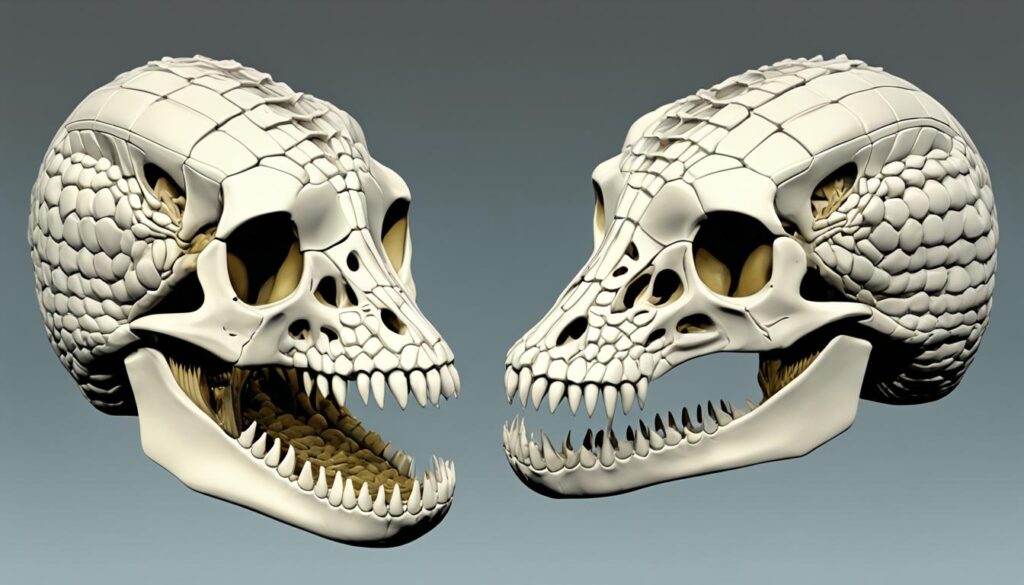
Research using CT scans of snake fossils and comparisons with modern reptiles has provided valuable insights into the evolution of snakes.
These findings have highlighted the significance of the snake skull and inner ear structures in understanding the adaptation and locomotion of these remarkable reptiles.
By examining the fossilized remains of a snake closely related to modern species, scientists have discovered a distinctive inner ear structure.
This unique feature is associated with animals that actively burrow, suggesting that snakes lost their limbs as they adapted to a burrowing lifestyle.
The inner ear plays a crucial role in balance and spatial perception, enabling organisms to navigate their surroundings effectively.
In snakes, the structure of the inner ear supports their remarkable ability to move through various environments, relying on their flexible bodies and scales.
The Role of Hox Genes in Snake Development
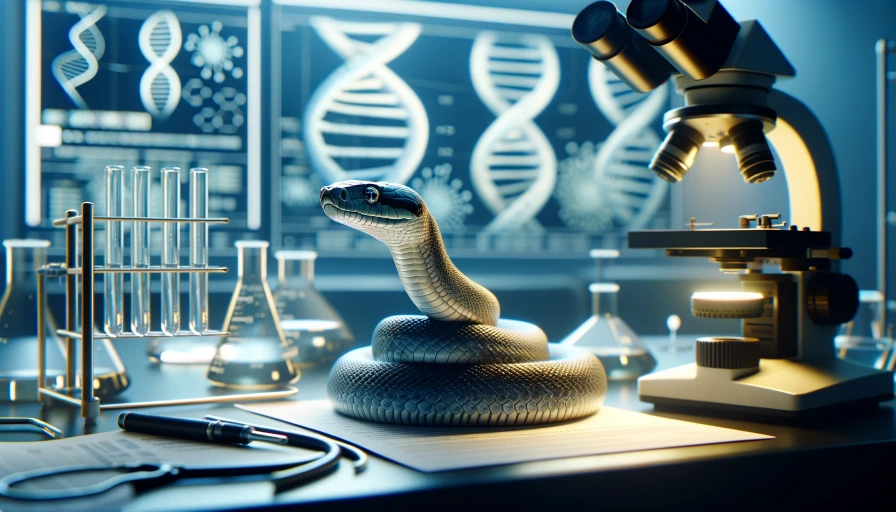
Hox genes play a critical role in the development of vertebrate body plans, including the formation of limbs.
These genes provide important instructions for the organization and differentiation of cells during embryonic development.
In the case of snakes, Hox genes are particularly significant in the patterning of embryos, specifically in determining the types of vertebrae that will form.
Research has shown that the expression of Hox genes is tightly regulated and coordinated, ensuring the proper development and positioning of structures along the snake’s body.
This includes the absence of limbs, as Hox gene expression patterns contribute to suppressing limb formation in snakes.
By studying the activity and regulation of Hox genes in snake embryos, researchers can gain insights into the genetic mechanisms behind the evolution of limblessness in snakes.
Understanding how these genes influence the development of snakes’ unique body structures can provide valuable information about the evolutionary adaptations that have allowed snakes to thrive without limbs.
Through previous research, scientists have discovered specific genetic changes in snake genomes, including alterations in Hox genes, that are responsible for the loss of limbs in snakes.
These findings highlight the crucial role of Hox genes in shaping the remarkable diversity of reptile anatomy and the evolutionary transformations that have occurred over millions of years.
Conclusion
Throughout their remarkable journey of evolution, snakes have adapted to their legless reptile existence through genetic changes, specialized body structures, and unique sensory capabilities.
Understanding the intricacies of snake evolution and reptile anatomy provides us with valuable insights into the diverse world of reptiles and the extraordinary adaptations that have enabled snakes to flourish in various environments.
From the loss of limbs in their ancestors to the genetic alterations in the PTCH1 gene responsible for limb development, snake evolution tells a fascinating story of adaptation and survival.
Snakes have replaced limbs with elongated bodies, flexible scales, and synchronized muscle movements, allowing them to slither and swim effortlessly through their habitats.
In addition to their physical adaptations, snakes have also developed extraordinary sensory capabilities.
The ability to “taste” scents with an organ on the roof of their mouths, detect infrared light with pit organs, and regenerate lost tissues are just a few examples of the adaptations that have made snakes formidable predators.
By unraveling the mysteries of snake evolution and studying reptile anatomy, we gain a deeper appreciation for these legless reptiles and the wonders of the natural world.
From their unique genetic makeup to their specialized body structures, snakes exemplify the extraordinary diversity of life on Earth.
Frequently Asked Questions
Q: How did the snake lose his legs?
Snakes evolved from lizards and lost their legs as an adaptation to burrowing and slithering. Over time, this evolution allowed snakes to move more stealthily and efficiently, which was advantageous for their survival and hunting strategies.
Q: Are snakes the only land animal without legs?
No, snakes are not the only land animals without legs. Other legless animals include various species of lizards, such as the slow worm, which have also evolved a legless form for similar burrowing or slithering lifestyles.
Q: What snake still has legs?
Some snake species, like the boa and python, have vestigial remnants of hind legs, known as pelvic spurs, which appear as small claw-like structures near their tail. These remnants are evolutionary leftovers from their legged ancestors.
Q: Do snakes have legs inside of them?
No, snakes do not have functional legs inside them. However, some species retain vestigial pelvic bones that support the theory of their legged ancestors. These are not functional legs but remnants of an evolutionary past.
Q: Do snakes have leg bones?
Most snakes do not have leg bones. However, some species, like boas and pythons, have vestigial leg bones, specifically the pelvic girdle, which are remnants from their evolutionary ancestors who had legs.
Q: Do snakes have legs inside the egg?
No, snakes do not have legs at any stage of their development inside the egg. They are fully adapted to a legless life from birth, and any leg-related structures are purely vestigial and not developed during embryonic stages.


